Vinyl vs laminate flooring: Vinyl vs. Laminate Flooring: What’s the Difference
Vinyl vs. Laminate Flooring: What’s the Difference
| Item | Purpose |
| Wear Layer | Clear aluminum oxide layer to protect floor against scratches |
| Print Layer | The image or look of the flooring |
| Core Layer | The main body of the floor, made of highly compressed wood fibers |
| Built-in Underlayment | Soft layer helps with uneven subfloors |
Laminate flooring, which is limited to planks, is similar to LVP in its look and method of installation. The critical difference is that its core is made from wood byproducts bonded with resins. The top surface is a hard, transparent plastic wear layer that covers the printed design layer. The overall thickness for laminate flooring planks ranges from 6 mm to 12 mm.
As with plank vinyl, a built-in underlayment is an option. Built-in underlayment is increasingly popular as DIYers decide they want to eliminate the step of rolling out separate underlayments.
Appearance
Laminate is the best flooring option for appearance. Both laminate and vinyl flooring are generally comparable in appearance, but more laminate options closely mimic hand-scraped hardwood, stone, ceramics, and other materials.
Laminate Flooring
Laminate flooring’s thick top layer allows for deep, realistic three-dimensional embossing on its surfaces, with accurate images of the natural material being portrayed.
Vinyl Flooring
Vinyl flooring isn’t known for its realistic looks but LVP is the most realistic of the bunch. Thicker solid-core vinyl flooring will look more like wood since deeper embossing is possible.
Margot Cavin / The Spruce
Cost
Vinyl and laminate flooring are competitively priced. However, sheet vinyl is often easier on the wallet.
Laminate Flooring
Laminate flooring ranges from about $1.00 per square foot for 7 mm-thick planks to about $5.00 per square foot for 12 mm-thick planks.
Vinyl Flooring
Vinyl flooring can cost as little as $1.00 per square foot for thin, glue-down vinyl flooring. Vinyl costs rise to around $5.00 per square foot for LVP, and premium brands will cost even more. For those looking to save as much money as possible, budget-friendly sheet vinyl options are available for as low as $0.65 per square foot.
Water Resistance
Vinyl flooring is more water-resistant than laminate. In fact, all types of vinyl flooring are considered waterproof because sheet vinyl, LVT, and LVP are made with materials that are 100% waterproof.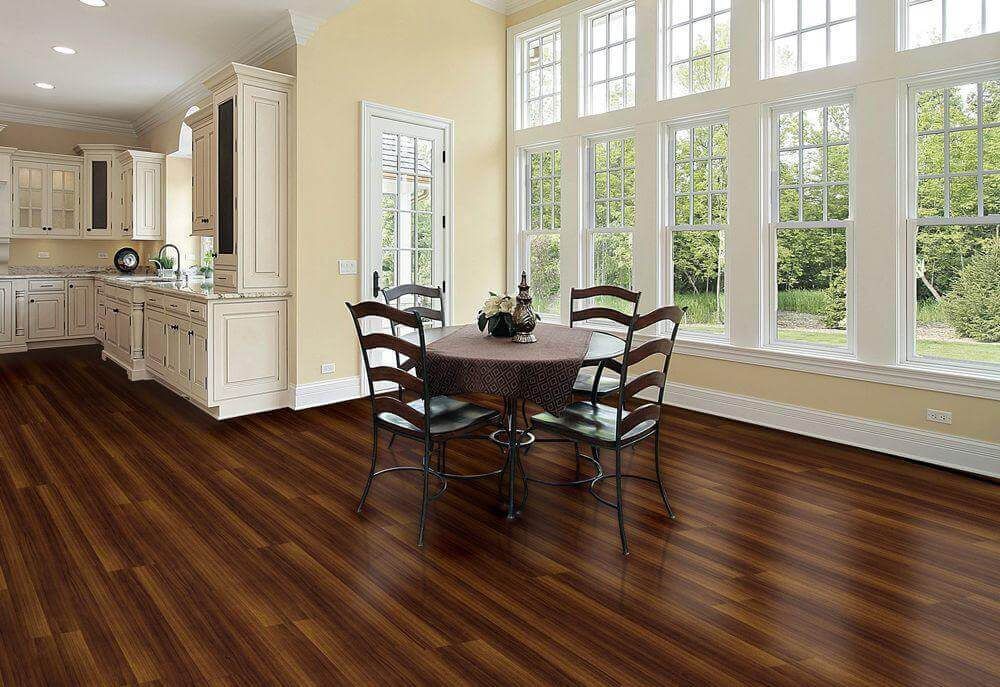
Laminate Flooring
Virtually all laminate flooring uses a fiberboard core. Because this core is a wood product, it will soften and swell if exposed to water. The fiberboard core won’t resume its original dimensions after it has dried. Additionally, the wear and design layers sometimes peel away after the core has become waterlogged. Severely water-damaged laminate flooring usually needs to be replaced; it cannot be fixed.
Properly installed laminate flooring, with tight seams and good baseboards or moldings, can tolerate pooled water for a short period. For family bathrooms or other areas where standing water is likely, traditional laminate flooring is a poor choice. However, there may be newer laminate materials that are better at resisting water.
Tip
If you can reasonably dedicate yourself to cleaning up occasional spills and puddles immediately, then laminate flooring may be used successfully in areas of low, intermittent moisture.
Vinyl Flooring
Modern vinyl flooring is waterproof. While older forms of vinyl flooring may have a fabric or felt backing that isn’t waterproof, newer iterations of vinyl flooring are made of 100% synthetic materials. Luxury vinyl flooring can be fully immersed in water for long periods, dried out, then reused, completely unaffected.
Warning
Just because a flooring material is waterproof doesn’t mean it offers protection to structural elements below. If possible, water should be removed immediately to avoid damage to the subfloor. Sheet vinyl that comes in 12-foot wide rolls often requires no seaming on smaller rooms, making it an excellent choice for a truly waterproof floor that protects the subfloor as well.
Margot Cavin / The Spruce
Heat Resistance
Neither vinyl nor laminate flooring is particularly heat resistant.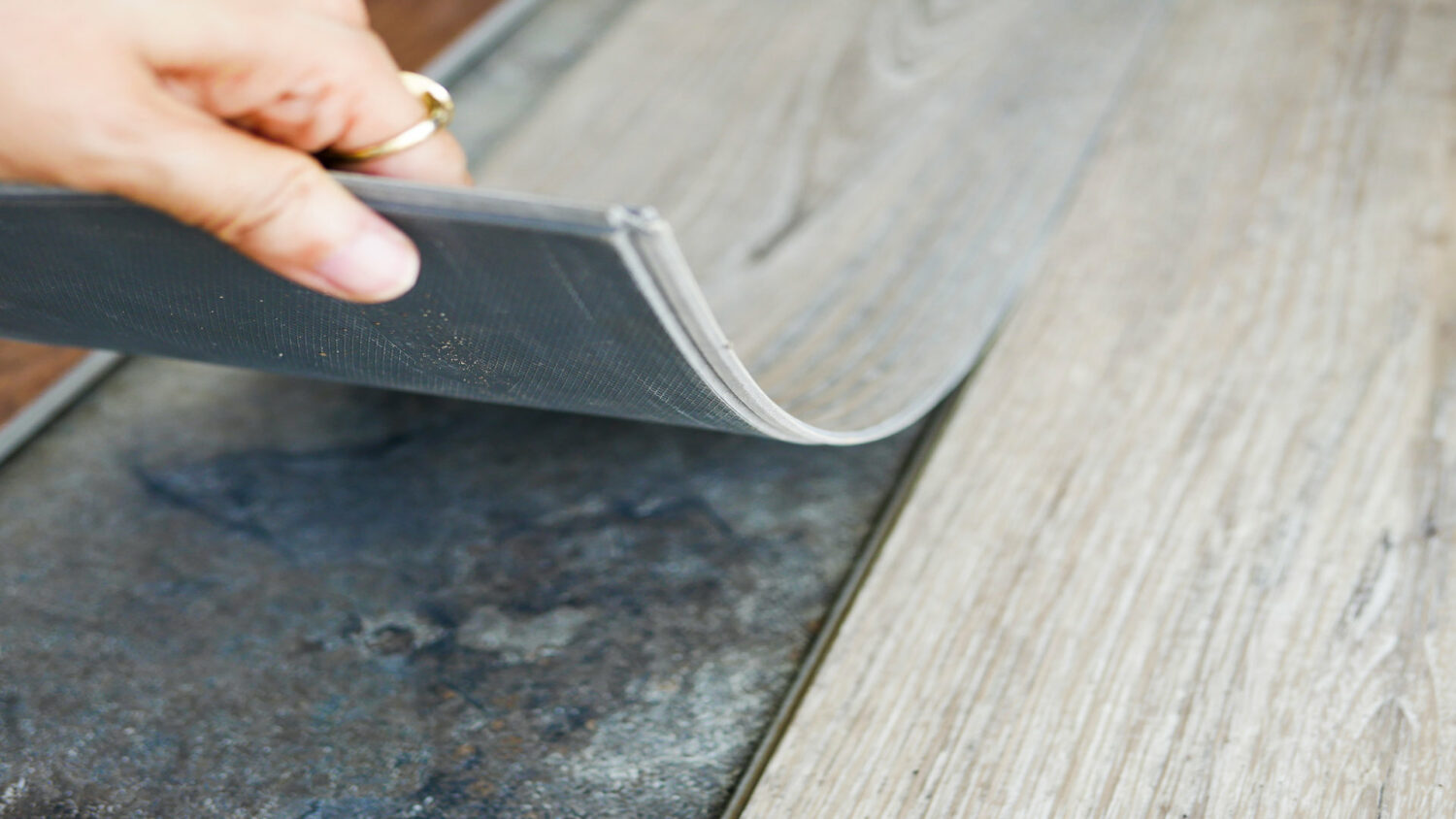
Laminate Flooring
Laminate flooring’s top layer could burn if you drop something extremely hot onto the surface. Additionally, laminate does not tolerate constant temperature changes in a room because it tends to expand and contract.
Vinyl Flooring
Like laminate, vinyl flooring can easily scorch if you drop something extremely hot on the surface. However, normal temperature fluctuations don’t affect vinyl flooring. Extreme ambient heat exposure can cause problems such as expansion and melted adhesive.
Care and Cleaning
Vinyl flooring is the easiest to thoroughly clean.
Laminate Flooring
Laminate flooring is best cleaned first with dry methods, such as with a dry mop or broom. If you need to wet-clean laminate flooring, you should use only a damp mop that feels almost dry to the touch.
Margot Cavin / The Spruce
How to Clean Vinyl Floors
Vinyl Flooring
Vinyl flooring’s strongest feature is that it’s so easy to care for and clean. Vinyl flooring in good condition can be wet-mopped and, if necessary, vigorously scrubbed with safe cleaning products.
Margot Cavin / The Spruce
Durability and Maintenance
Vinyl is more durable than laminate flooring. Vinyl flooring is a supremely durable, low-maintenance flooring, thus the industry term resilient flooring. Vinyl flooring is even used in commercial applications, where durability and maintenance are high priorities.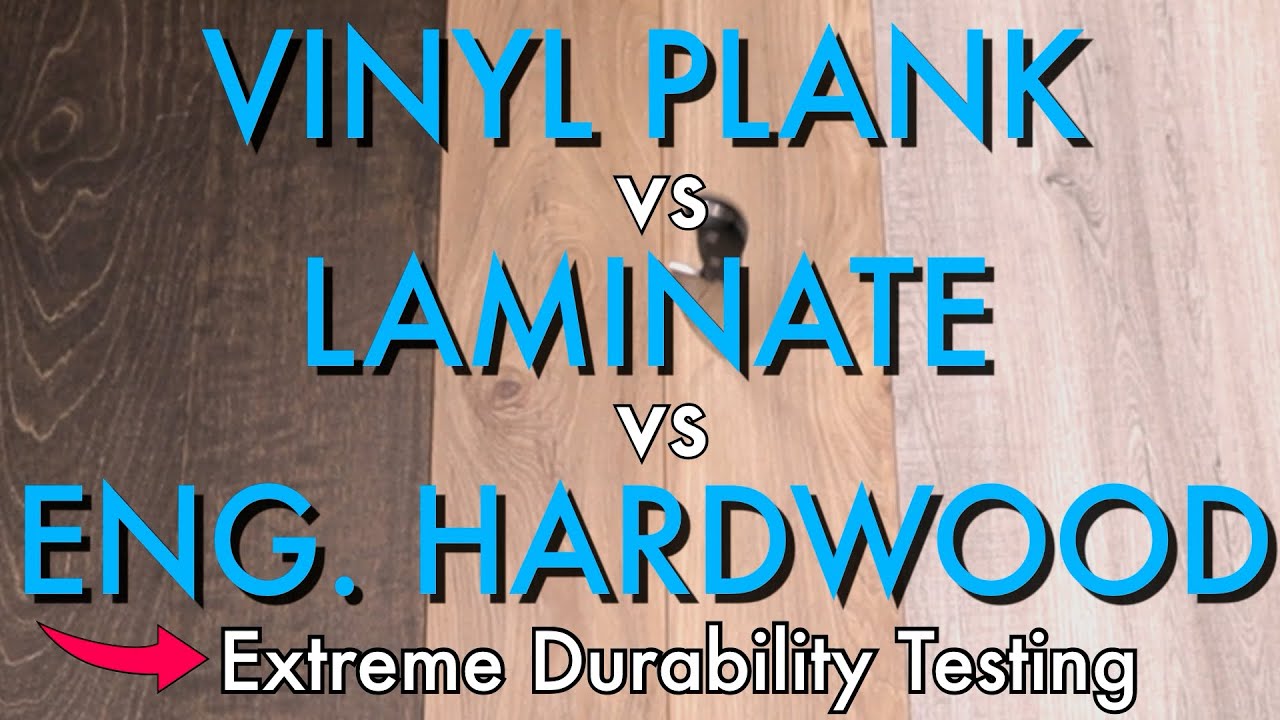
Tip
If you’re looking for the best flooring option for pets, vinyl is the winner. In addition, laminate is slippery and may become very loud under the “click-click” of large pet toenails.
Laminate Flooring
Laminate flooring is durable and low maintenance. However, laminate flooring’s many layers may eventually delaminate over time, especially if it’s exposed to water for too long. Once the laminate’s top wear layer is scratched or chipped, it cannot be repaired. Once delamination starts to happen, the top layers begin to peel up and allow water to enter the lower layers.
Vinyl Flooring
Vinyl flooring is a tough flooring material that will stand up to high traffic demands. Thin vinyl flooring has a slight advantage over thick vinyl flooring, which can potentially delaminate over time. With the thin flooring, delamination isn’t a concern because it’s a single cohesive layer of polyvinyl chloride (PVC). Thicker, more expensive plank vinyl flooring’s soft underlayment is the weak link in its layering system and has the potential to delaminate.
Margot Cavin / The Spruce
Installation
The ease of installation of vinyl vs laminate flooring is similar. Both materials have advantages and disadvantages when it comes to ease of installation. Vinyl or laminate planks are easier to DIY install than sheet vinyl. Vinyl needs fewer tools than laminate. Installing laminate flooring requires a saw and a certain skill level to use it correctly to cut down on the amount of waste.
Laminate Flooring
Laminate flooring uses a click-and-lock installation method, where the tongue of one plank is fitted into the groove of an adjoining plank at an angle. Then the first plank is folded down until it’s level with the other plank. This action draws the boards together and closes the seam. An ordinary circular saw or table saw equipped with a fine-tooth blade, or even a hand saw, is used to cut laminate planks.
Vinyl Flooring
Vinyl planks also use a click-and-lock method of installation.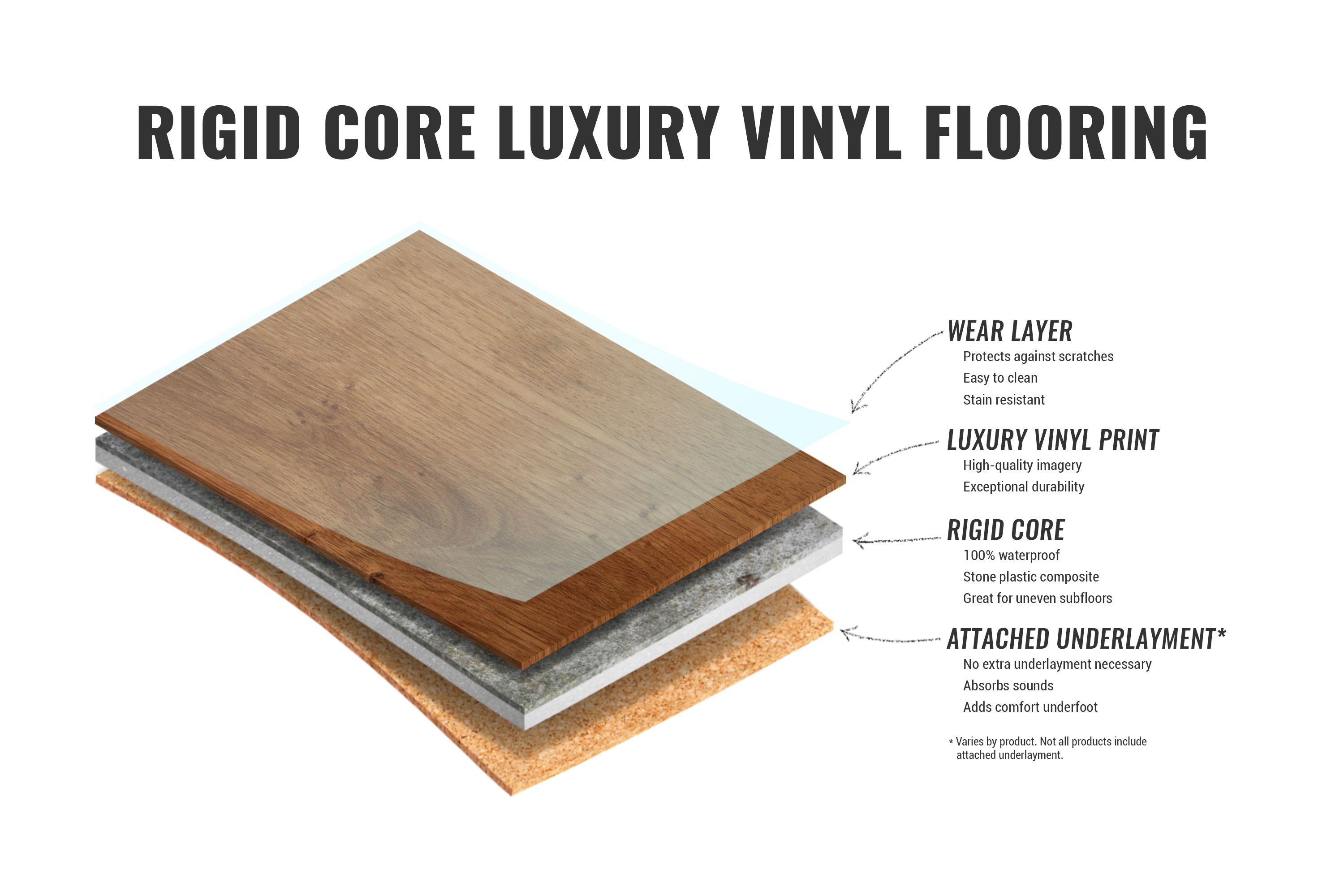
Sheet vinyl flooring does have its disadvantages: sheet vinyl can be a difficult material for DIYers to install. The material is large, heavy, and unwieldy. Plus, it can be hard to make complicated cutouts from sheet goods. If you are installing sheet vinyl, professional installation is often your best bet.
Lifespan
Laminate and vinyl flooring have similar lifespans if properly cared for. As long as laminate flooring is kept reasonably dry and is regularly cleaned, buyers may expect lifespans close to that of vinyl flooring.
Laminate Flooring
Laminate flooring warranties typically range from 10 to 25 years, but this is dependent on a rigorous maintenance schedule.
Vinyl Flooring
Warranties on luxury vinyl flooring often range up to 20 years.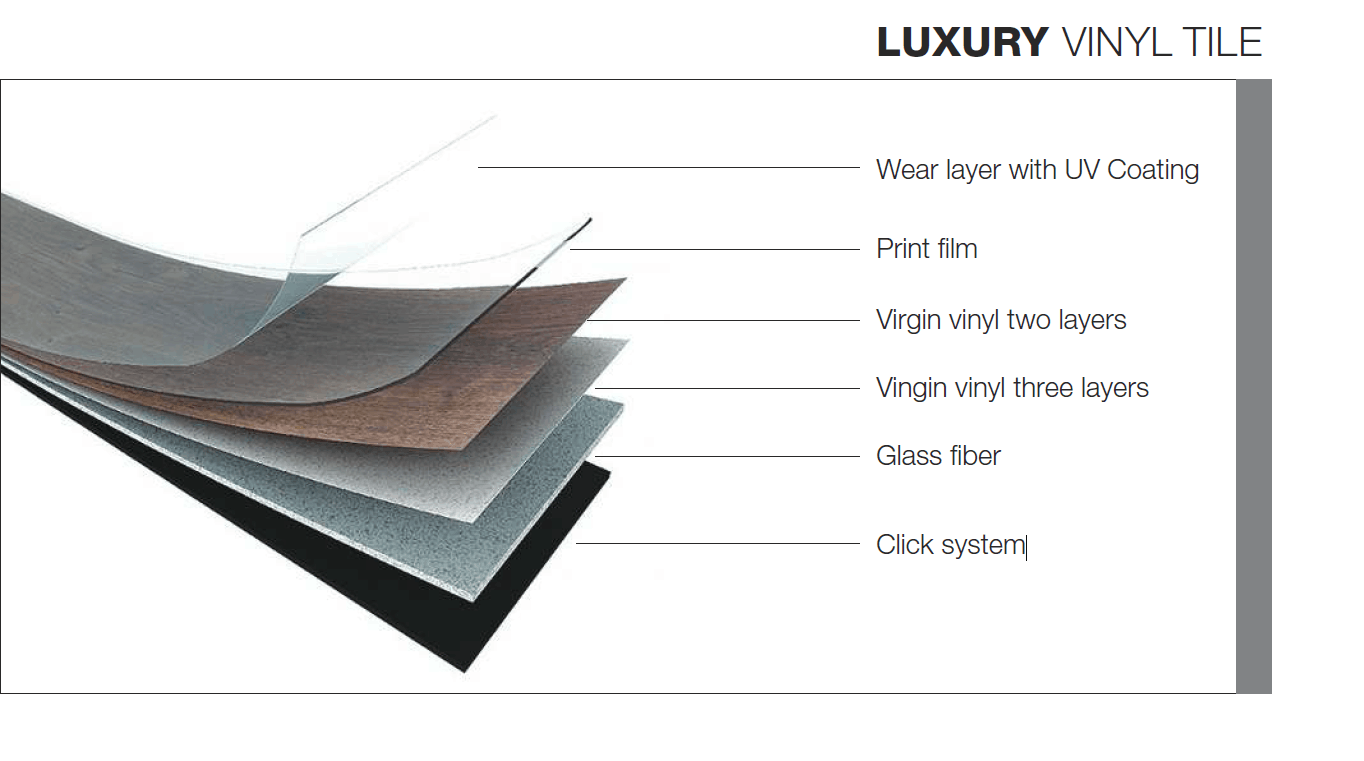
Comfort & Sound
Both laminate and vinyl flooring can be quiet and comfortable to walk on. Laminate flooring products can feel and sound somewhat hollow underfoot when compared to the wood floors they are supposed to mimic. But when combined with either foam or felt underlayment, laminate flooring may be quieter, softer, and more comfortable to walk on.
Laminate Flooring
Though laminate flooring does not feel like wood, it does have a warm feeling, especially when coupled with premium-quality underlayment. You can commonly hear people walking on laminate if they are wearing heels.
Vinyl Flooring
Vinyl floors of all types can feel cold or hard on the feet, especially when they are installed over concrete or existing ceramic tile floors. But walking with heels on vinyl flooring is typically quiet.
Resale Value
Quality laminate flooring and vinyl flooring lend a comparable amount of value to a home.
Laminate Flooring
Premium laminate flooring can lend extra resale value to a home, as long as it’s relatively new and in good condition.
Vinyl Flooring
Major brand luxury vinyl plank flooring will bring decent resale value to a home. However, cheap vinyl flooring will often be seen by buyers as a project-in-waiting once the house has sold.
Environmental Impact
Neither laminate nor vinyl flooring is significantly environmentally friendly. If using green building materials is important to you, laminate flooring has a small advantage, thanks to the natural wood content of the fiberboard core. Still, neither of these materials is especially environmentally friendly in the way that natural wood, linoleum, or bamboo floor coverings are.
Laminate Flooring
Some laminate flooring manufacturers offer products that qualify for LEED MR4 (Recycled Content) status. But laminate flooring still uses a plastic surface layer, and the melamine resins used in the creation of the core level are by no means green materials since they may off-gas chemicals.
Vinyl Flooring
Vinyl flooring has improved its green stature in recent years. Some vinyl flooring manufacturers now offer products that achieve a LEED credit EQ4.3 for Low-Emitting Material. Vinyl is a synthetic material that is known to produce toxic chemicals when burned. Vinyl does not decompose in landfills, and recycling it is usually not an option.
Stain Resistance
Laminate and vinyl flooring are both stain-resistant. Good quality modern vinyl flooring and laminate flooring both receive wear layers treated with properties that do an excellent job of resisting stains.
Laminate Flooring
The top layer of laminate flooring is a clear aluminum oxide layer that is superior for stain resistance.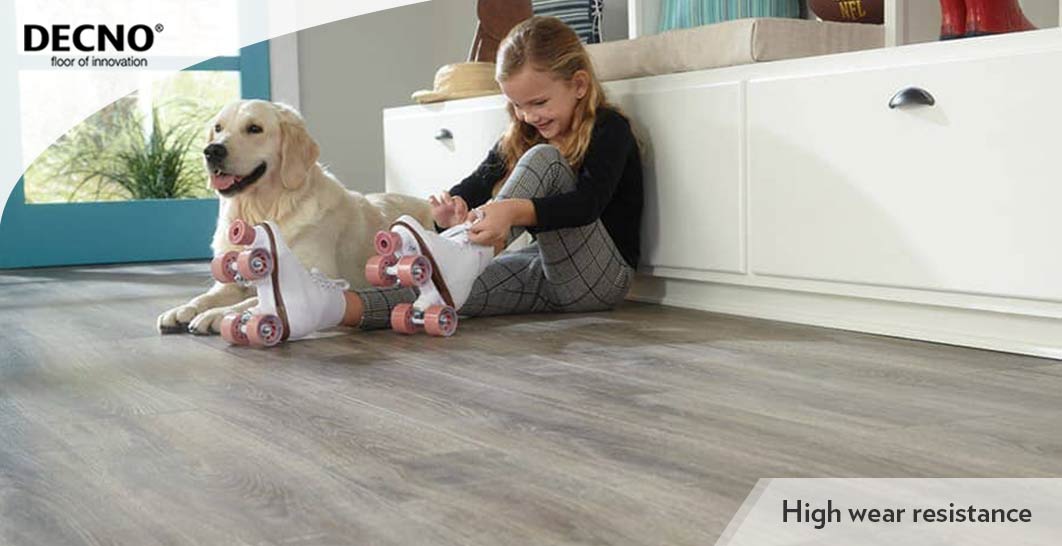
Vinyl Flooring
Quality vinyl flooring is coated with a transparent urethane layer that provides excellent stain resistance.
Recommended Installation Areas
Vinyl can be installed throughout the home, while laminate should only be used in certain areas. So, is vinyl or laminate flooring a better option for your space?
Installation Areas: What Is Better?
Vinyl flooring outperforms laminate flooring in the area of water resistance, making it a go-to flooring material for areas that are prone to water and moisture exposure.
| Installation Areas | Laminate Flooring | Vinyl Flooring |
|---|---|---|
| Bathroom, Full or Partial | No | Yes |
| Powder Room | Maybe | Yes |
| Kitchen | Maybe | Yes |
| Dining Room | Yes | Yes |
| Living Room | Yes | Yes |
| Bedroom | Yes | Yes |
| Home Office | Yes | Yes |
| Mudroom | No | Yes |
| Basement | No | Yes |
Which Is Better?: Laminate or Vinyl Flooring
When it comes to laminate vs vinyl flooring, one is not any better or worse than the other.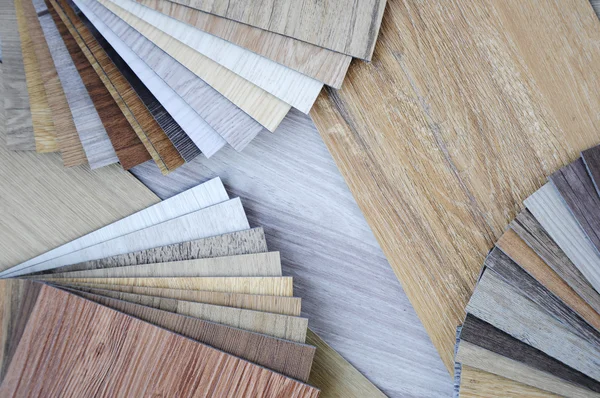
Top Brands
Laminate Flooring
- Dream Home (Lumber Liquidators / LL Flooring)
- Pergo
- QuickStep
Vinyl Flooring
- Armstrong
- Mannington
- Shaw
FAQ
-
The main difference between laminate and vinyl flooring is the materials they’re made of. Vinyl is 100% synthetic, while laminate uses a fiberboard core constructed of wood byproducts. Thus, laminate flooring is not waterproof, while vinyl flooring is 100% waterproof. Both floorings are stain-resistant and offer the option of underlayment, but are built a bit differently.
-
Vinyl and laminate flooring are similarly priced, though sheet vinyl can sometimes be found slightly cheaper. Luxury vinyl options can be much more expensive than laminate.
-
Laminate and vinyl flooring have similar lifespans when properly cared for, though vinyl flooring is considered more resilient, which may ensure a longer lifespan for many users.
-
Vinyl flooring is superior to laminate when it comes to pets. This is due to vinyl’s 100% synthetic constructions, which makes it waterproof.
-
Vinyl flooring is more scratch resistant than laminate flooring, but LVT and LVP may be more prone to top-layer tearing.
Top Flooring Options for Your House
Vinyl Plank Flooring Pros and Cons
Sheet vinyl and vinyl tile have long been favorite flooring materials for kitchens and bathrooms, but it has always been viewed as slightly cheap when compared to other flooring materials. But that is no longer the case with vinyl plank flooring, also known as luxury vinyl flooring (LVF) or luxury vinyl plank flooring (LVP).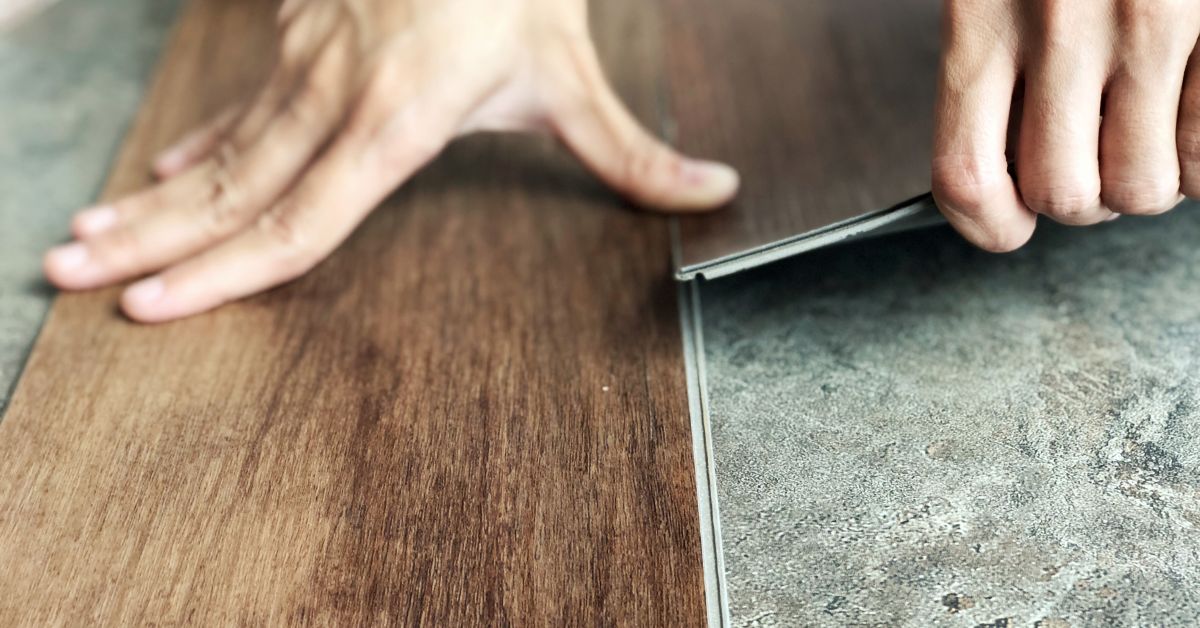
Vinyl plank flooring originally became popular because it mimicked wood plank flooring very convincingly—more so than even plastic laminate flooring. But there has since been an explosion of offerings for vinyl plank flooring, including products that look like ceramic and porcelain, and natural stone like marble or granite. The stone-look products are usually shaped in tiles, rather than planks.
Pros
-
Fully waterproof
-
Easy to install
-
Simple to maintain
Cons
-
Damaged planks difficult to repair
-
May not always resemble wood
-
Click-lock joints may be difficult to attach
What Is Vinyl Plank Flooring?
At its heart, plank vinyl floor, also called luxury vinyl plank (LVP) or luxury vinyl floor (LVF), is simply vinyl flooring that comes in long, narrow strips rather than the traditional square tile shapes.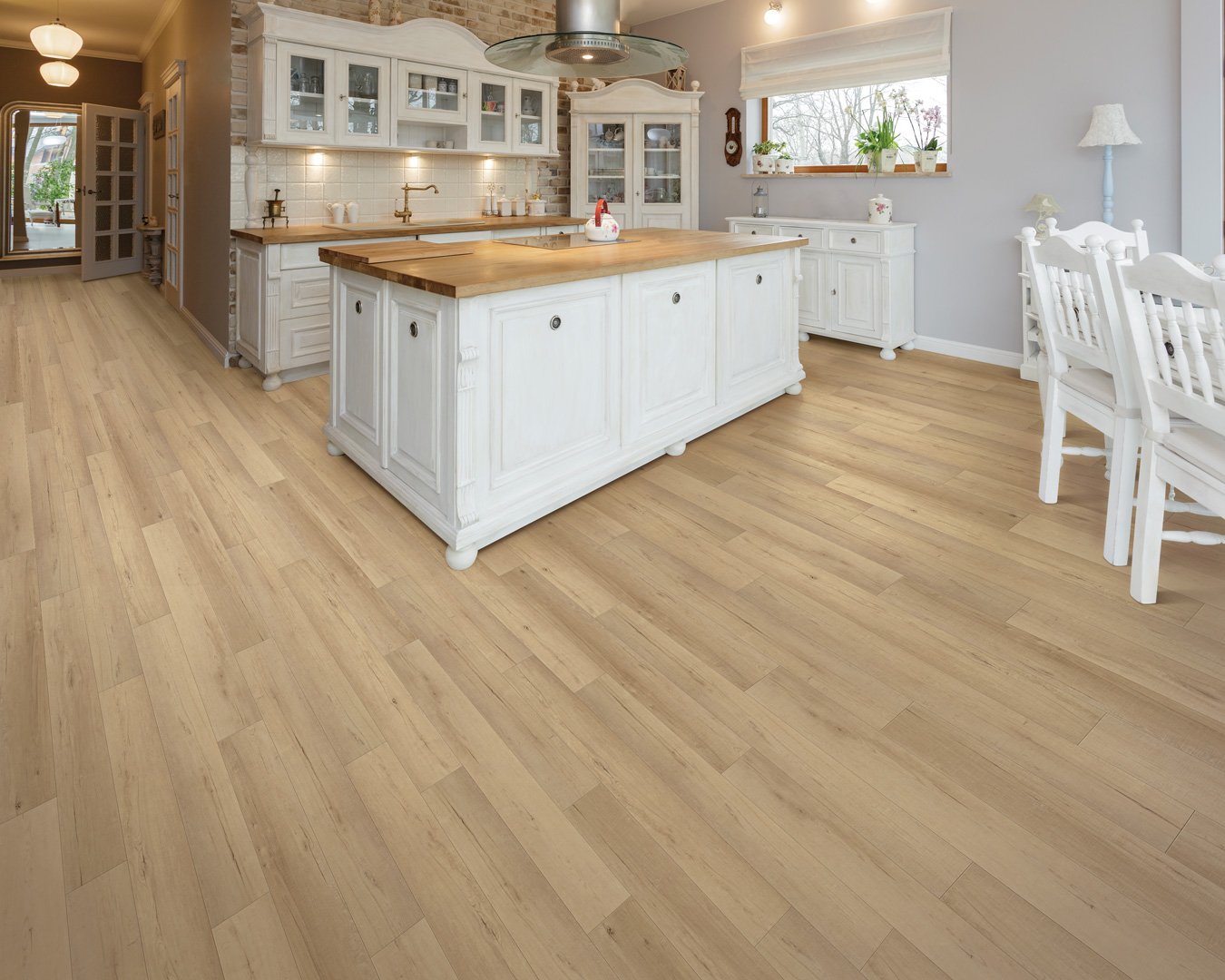
- A topmost layer of aluminum oxide, designed to prevent light scratching and scuffs
- A clear film layer that protects against more severe ripping and tearing
- A design layer that provides the photo-realistic look of wood or stone
- A backing layer made of fairly rigid vinyl, comprising almost 90 percent of the total thickness of luxury vinyl
Luxury vinyl is therefore almost five times thicker than traditional sheet vinyl, allowing it to be semi-rigid. Rather than being rolled out over the floor and glued down, luxury vinyl planks snap together. Manufacturers of luxury plank flooring offer dozens of different styles to match the distinctive appearance of different wood species—right down to textured surfaces that mimic real wood grain.
You can even find vinyl planks with a heavily antiqued or distressed look, hand-scraped, dinged, scratched, and peppered with nail holes. But these products are more expensive since the planks need to be quite thick to handle such deeply textured embossing.
Vinyl flooring planks typically are 48 or 36 inches long. With most planks, the width is about 6 inches, though some go as much as 7 3/4 inches wide.
Click Play to Learn the Pros and Cons of Vinyl Plank Flooring
Vinyl Plank Flooring Cost
Rarely will a vinyl plank floor cost as much as genuine wood flooring, which is usually five to 10 times more expensive than vinyl planks. Prices for materials usually range from $2.50 to $5 per square foot. Professional installation can add $1 to $3 per square foot, but this is one of the easier flooring materials to install yourself—comparable to plastic laminate flooring planks.
Material costs for luxury vinyl plank prices are comparable to ceramic/porcelain tile, but with tile, you must factor in the cost of additional materials (thinset and grout), plus tile-specific tools. And ceramic tile is a much more labor-intensive installation for DIYers.
Maintenance and Repair
This is one of the easier floors to maintain. Most manufacturers recommend simple sweeping daily, and weekly damp mopping with a mild detergent and mop, or with cleaning pads. These floors should never be steam-cleaned, however. While the flooring itself is impervious to moisture, the pressure of a steam cleaner can potentially drive moisture down through the seams to the wooden subfloor.
Repairs can be a little tricky with vinyl plank flooring. You may be able to repair small areas of damage with a vinyl repair kit chosen to match the color of your flooring.:max_bytes(150000):strip_icc()/vinyl-vs-laminate-flooring-1822800_cleaning_laminate-fc46572a1e454357ad896e51490207de.jpg)
Design
Vinyl plank flooring is offered in hundreds of colors and patterns from the major flooring manufacturers. Interior designers and real estate professionals regard it as superior flooring to sheet vinyl and laminate flooring, but still considerably less prestigious than solid hardwood or porcelain tile.
Most plank forms of luxury vinyl seek to mimic hardwood flooring, and they do this quite effectively. At a casual glance, vinyl planks can look quite similar to natural wood—it can be a better illusion than what is offered by laminate flooring. Tile forms of luxury vinyl generally seek to mimic ceramics or natural stone—again, quite effectively.
Vinyl Plank Flooring Installation
Ease of installation is a key advantage of vinyl plank flooring.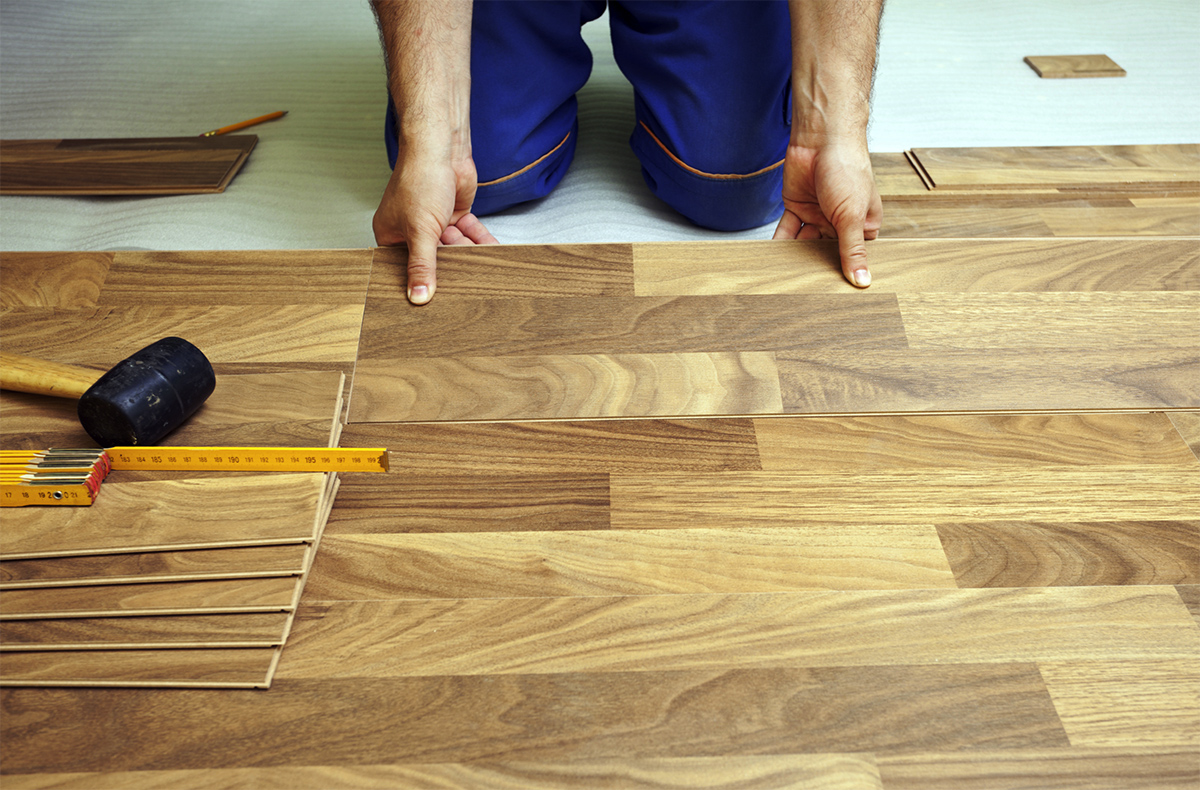
Vinyl plank flooring uses a click-lock system in which the edges and ends of the planks snap together. This flooring is generally installed as a floating floor that simply rests on the underlayment with no glue-down bond necessary. While the subfloor and underlayment should be as flat as possible, vinyl planks are considerably thicker than sheet vinyl, making it more forgiving of small imperfections in the underlayment—flaws that can telegraph through to the surface on sheet vinyl.
Installation begins by laying the first row of planks along the most visible side of the room. At end walls, the planks can be cut by a sharp utility knife, and tin snips can be used to cut notches and openings for obstructions.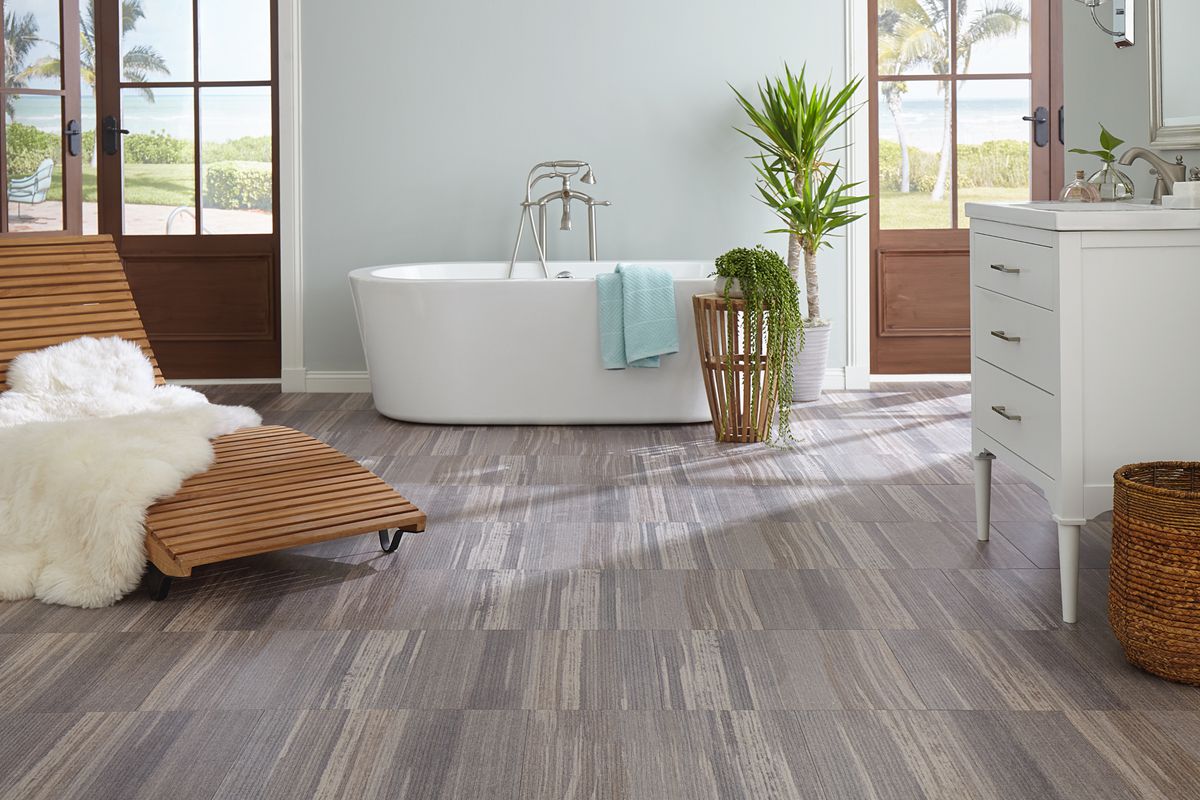
Click Play to Learn How to Install Vinyl Plank Flooring
Top Brands of Vinyl Plank Flooring
These five manufactures all offer good vinyl plank flooring products at various quality levels:
- Premio and Classico, from Shaw: Major flooring manufacturer Shaw offers Premio and Classico as its premium luxury plank lines. While Shaw has thick (6.5 mm) and gorgeous luxury vinyl products, not every product line can be considered top-shelf. For example, Aviator and Navigator lines are Shaw’s bargain products.
- Armstrong: One of the oldest flooring companies, Armstrong continues to hold strong. Armstrong makes mid-range quality LVP, all in respectable thicknesses and replica wood species. Armstrong offers the Luxe Plank line, which is renowned for its simplicity. Unique among vinyl floors, this product uses a self-stick adhesive.
- Adura and Distinctive, from Mannington: Like Armstrong, Mannington is a solid company with quality offerings.
The popular Mannington Adura is a good choice. But if you want real wood plank looks, you need to upgrade to their Distinctive line in full 6 x 48-inch sizes, micro-bevel “eased” edges, pleasant coloration, and more realistic embossing.
- BuildDirect: Online-only bargain LVF leader BuildDirect routinely offers the cheapest possible planks, but there are stipulations. Due to BuildDirect’s pricing structure, you often have to buy a minimum number of square feet to obtain those rock-bottom prices. Consequently, BuildDirect’s low prices tend to favor homeowners who are installing large quantities of flooring.
- Tranquility, from Lumber Liquidators: Expect extremely low prices at Lumber Liquidators, the brick-and-mortar equivalent of BuildDirect. At one end of the price scale is their house brand Tranquility line, which sells very thin LVP, North Perry Pine, at 1.5 mm thick. At the other end of the scale, Lumber Liquidators has a healthy selection of quality, thick 5 mm thick planks in 7-inch widths.
Comfort and Convenience
Vinyl plank flooring offers much of the easy-care convenience of sheet vinyl, but because it is a thicker material, it has slightly more “give” underfoot, making it more comfortable. Because it is made from waterproof materials through and through, this is a much better flooring for damp areas than laminate flooring or hardwood. In a kitchen, bathroom, mudroom, or laundry, few flooring materials are better choices.
Vinyl Plank Flooring vs. Laminate Flooring
Because they both seek to mimic natural hardwood, homeowners are often faced with choosing between vinyl planks and laminate flooring. By most comparisons, today’s vinyl plank flooring may be slightly superior.
Both have very similar installation techniques, with click-lock installation that floats over the underlayment. Vinyl, however, can be cut with a simple utility knife, while laminates require a power saw. Vinyl is a fully waterproof material, is somewhat softer than laminate, and is less noisy underfoot.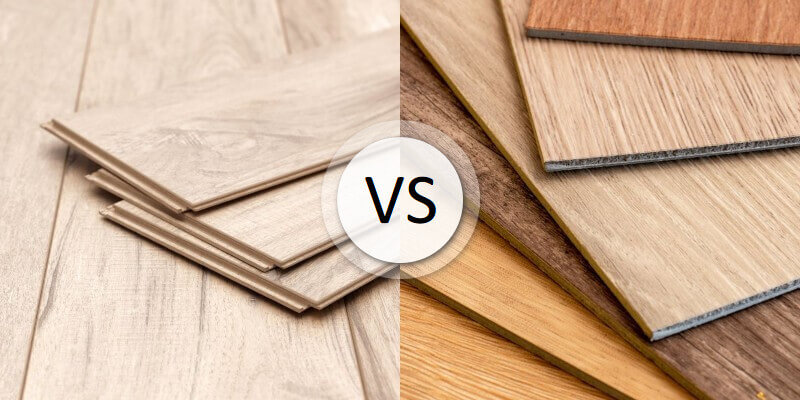
Early forms of vinyl plank flooring were perfectly smooth, without the texturizing found in many laminate flooring products. But today’s vinyl planks can create the same embossed texture, and when combined with its other performance advantages, vinyl may be the better choice for many situations.
The 7 Best Home Gym Floors of 2023
Laminate or Vinyl. What’s better? Big comparison
December 27, 2020
Today, in the flooring market, a large number of materials. It is difficult to choose, given the many pros and cons of each of them. We decided to make a comparison of all modern floor coverings. We have already compared: Laminate and Parquet, Vinyl and Tiles, Cork and Parquet. We continue our series of articles with the most popular coatings: vinyl floors (including all LVT, Rigid, SPC options) and laminate.
Price
Vinyl and laminate flooring come in many price ranges. But, the cheapest vinyl is 2 times more expensive than cheap laminate flooring offers. In the high price segment, the difference is not so big, but the vinyl floor is still 20-30% more expensive.
Vinyl: 0 points. Laminate: 1 point
Environmental friendliness
Laminate, despite various additives, mainly consists of wood fibers. Vinyl, on the other hand, is almost completely based on artificial materials (not counting SPC). At the same time, the release of harmful substances into the air is at a minimum level for both coatings. But still, due to the composition, the laminate wins.
Vinyl: 0 points. Laminate: 2 points
Water resistant
Laminate is a moisture resistant floor covering. There is also a waterproof laminate, but this protection is valid for a limited time when in contact with water.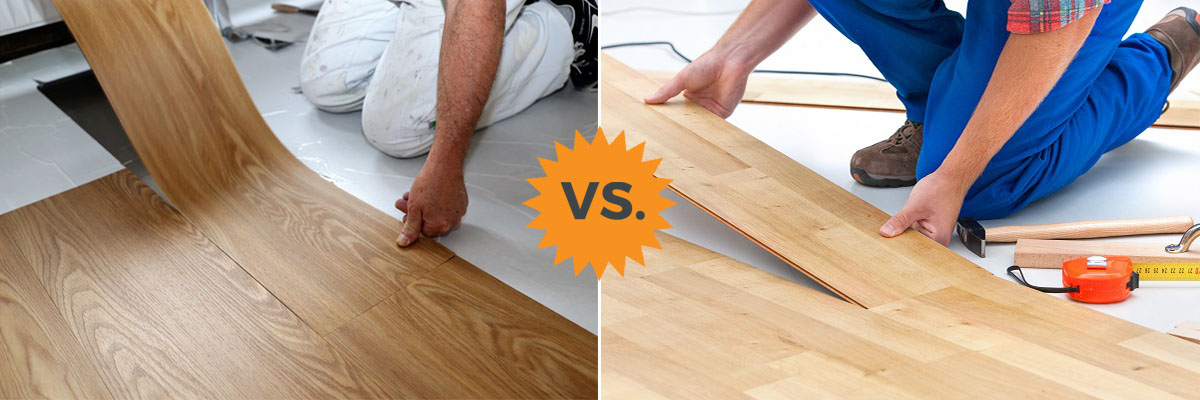
Vinyl: 1 point . Laminate: 2 points
Structure
A very important characteristic for a floor is its texture to the touch. Pleasant tactile sensations from walking barefoot are important for home comfort. This also affects the appearance. Laminate, thanks to the protective layer, can have a deeper and more natural pattern. Expensive laminate flooring options are almost indistinguishable from natural wood. Vinyl flooring also has deep wood grain options, but these are a small number of expensive items. In the cheap segment, vinyl and laminate are similar in structure.
Vinyl: 1 point Laminate: 3 points
Durability
Laminate is designed for both commercial and domestic applications. It is quite durable in terms of wear resistance, but vinyl flooring was originally designed for heavy loads (up to storage facilities).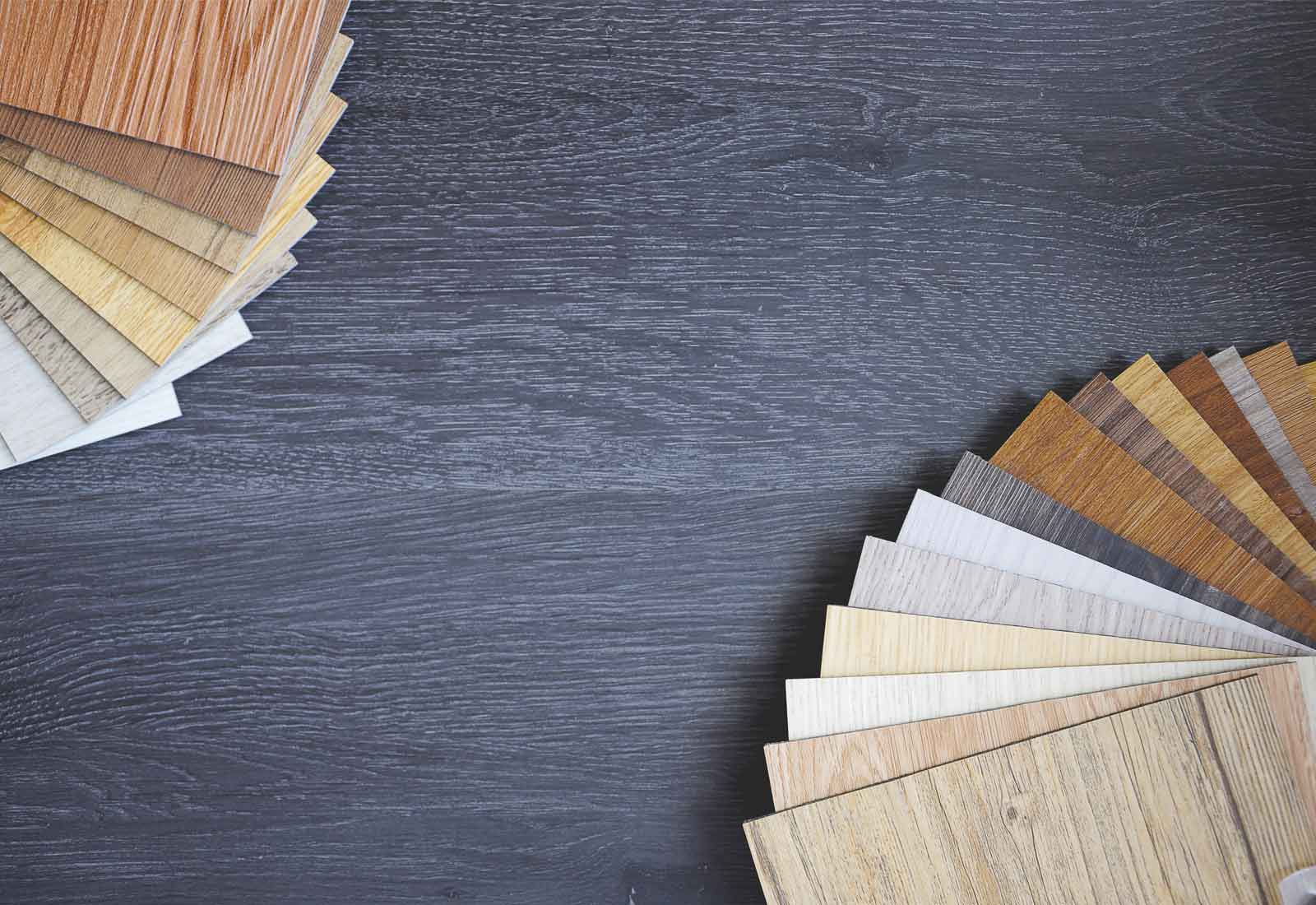
Vinyl: 2 points . Laminate: 3 points
Impact resistance
Vinyl is a flexible coating. Most hits from falling objects will not cause harm. At worst, there will be a dent. On the laminate, on the other hand, with a strong impact, chips occur and this leads to destruction.
Vinyl: 3 points . Laminate: 3 points
Warmth
Vinyl is thinner than laminate and also has less thermal insulation. Therefore, the laminate floor will be warmer. If you use interlocking vinyl with an underlay, then the vinyl floor can be made a little warmer, but still colder than the laminate.
Vinyl: 3 points. Laminate: 4 points
Underfloor heating
Due to its high density and low thermal insulation, vinyl flooring is an excellent option for underfloor heating.
Vinyl: 4 points . Laminate: 4 points
Silence
Vinyl flooring is a soft flooring. When walking and hitting, there is no noise and rumble. Lock vinyl is much quieter, but even adhesive or SPC is a quiet floor. Laminate is a hard and resonant flooring. You can significantly reduce noise using specialized substrates, but vinyl will still be quieter.
Vinyl: 5 points . Laminate: 4 points
Walking comfort
The elasticity of the vinyl floor makes it comfortable to walk on. Of course, adhesive options are very thin, and SPC vinyl is more rigid, but it is still more comfortable than laminate.
Vinyl: 6 points .
Fire Rating
Almost all manufacturers of laminate flooring have a C(fl) s1 fire rating, and all vinyl flooring is rated B(fl) s1. That is, vinyl is a class higher and safer in this characteristic. At the same time, the laminate from the Spanish manufacturer Faus; also has an increased fire resistance B (fl) s1, but this is an exception.
Vinyl: 7 points . Laminate: 4 points
Repair
For minor damage to the laminate, repair kits can be used. But with significant damage, it is difficult to replace the board. Once damaged, a vinyl floor cannot be repaired. But replacing one bar is much easier. It is also important that the vinyl floor does not lose its properties when damaged, but still the ball behind the laminate.
Vinyl: 7 points. Laminate: 5 points
Choice of decors, designs
Vinyl flooring is available in many color options for tile/stone or wood. But laminate is much more diverse in size and colors.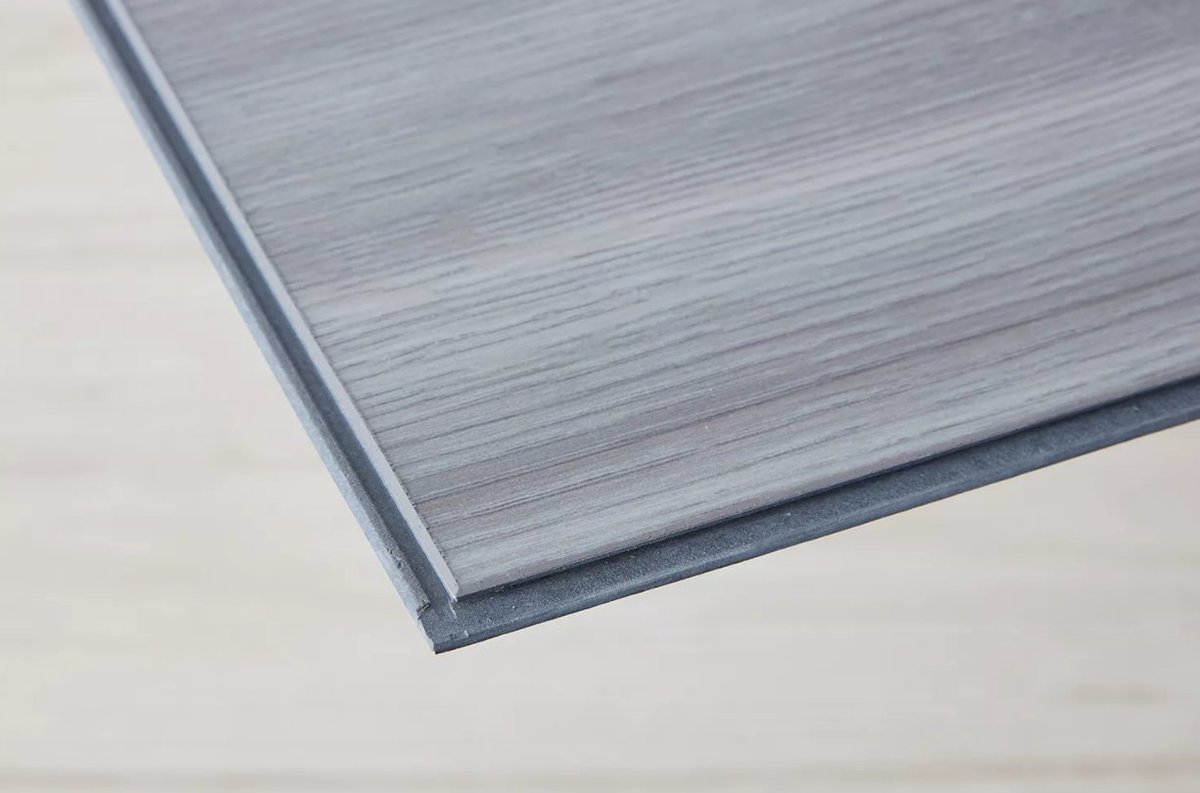
Vinyl: 7 points. Laminate: 6 points
Ease and cost of installation
Vinyl flooring is very easy to install. You need a minimum number of tools and reading the instructions. The absence of dust and dirt during installation is also very important. The cost of laying vinyl is not very high. But the laminate is less whimsical to the base and has a very simple locking system. Laminate flooring costs less than vinyl flooring.
Vinyl: 7 points. Laminate: 7 points
Total
We don’t have a winner. Both coatings have many advantages, but also small disadvantages. If you are looking for a large number of decors at a good price and will not use underfloor heating, then you can choose a laminate. If a quiet and waterproof floor is important to you, then vinyl is definitely the choice. In any case, the choice is yours!
Vinyl vs.
| Vinyl | Laminate | |
| Price | + | |
| Eco friendly | + | |
| Water resistance | + | |
| Structure | + | |
| Wear resistance | + | |
| Impact resistance | + | |
| Heat | + | |
| Underfloor heating | + | |
| Silence | + | |
| Comfort | + | |
| Fire resistance | + | |
| Repair | + | |
| Decor | + | |
| Stacking | + | |
| 7 | 7 |
Share
Share
Share
New comment
Sign in with
Submit
Difference between laminate and vinyl laminate
Moisture resistant laminate
Laminate is a flooring that imitates parquet boards, natural stone and significantly outperforms natural wood flooring.
Vinyl lamellas and wood laminates are easy to install. Standard laminate is installed end to end using a locking system. PVC lamellas, in addition to the locking method, also imply fastening with an adhesive. On sale there is a vinyl laminate on which an adhesive layer is already applied and covered with a protective film. This greatly simplifies the process of laying the flooring.
Technical and external characteristics
Adhesive vinyl floors
Classic and vinyl laminate are practically indistinguishable from the outside. This is due to the fact that both floor coverings have a top decorative layer, usually printed on a film.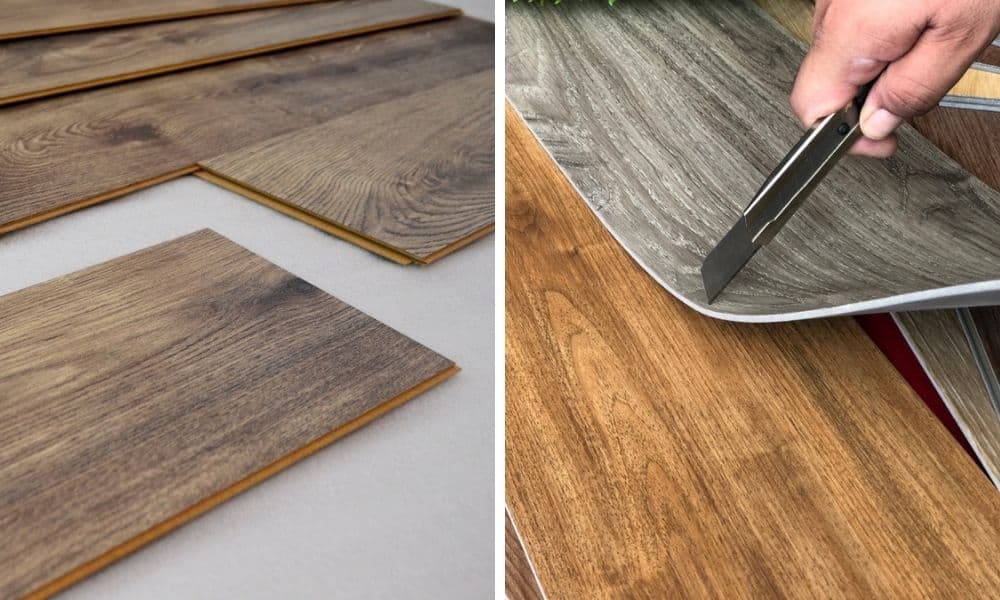
To ensure safety, it is necessary to purchase a laminate with all necessary documentation and quality certificates. But if we consider vinyl and classic laminate in terms of antibacterial properties, the second option is significantly inferior to the first in terms of performance. Vinyl laminate, consisting of polyvinyl chloride, quartz and limestone, does not promote the growth of bacteria and germs, which is an important condition for users suffering from allergies. In addition, the presence of a unique protective layer allows you to provide full protection against chips and scuffs.

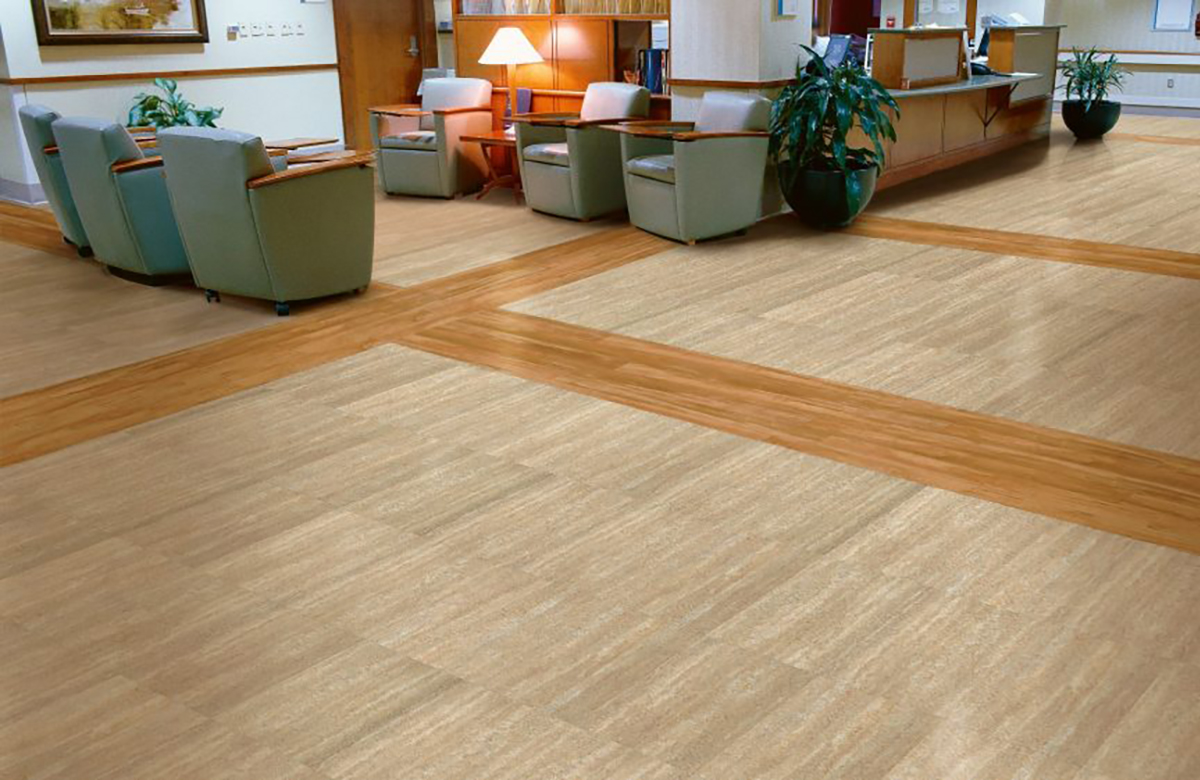 The popular Mannington Adura is a good choice. But if you want real wood plank looks, you need to upgrade to their Distinctive line in full 6 x 48-inch sizes, micro-bevel “eased” edges, pleasant coloration, and more realistic embossing.
The popular Mannington Adura is a good choice. But if you want real wood plank looks, you need to upgrade to their Distinctive line in full 6 x 48-inch sizes, micro-bevel “eased” edges, pleasant coloration, and more realistic embossing.
